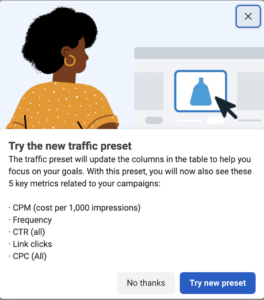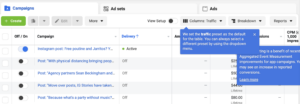
Understanding the Power of Facebook Ad Terms: Exploring the “Try the New Traffic Preset”
In today’s digital age, social media platforms have become a significant driver of marketing strategies. Facebook, being one of the most popular platforms, offers a wide range of advertising tools and features to help businesses effectively reach their target audience. However, navigating through the various ad terms and understanding their implications can be a daunting task. Dont worry, we can help too.
Let’s delve into the meaning and significance of the “Try the New Traffic Preset” feature in Facebook ads, shedding light on the key metrics it offers and how they can benefit food marketers.

What is the Traffic Preset?
The “Try the New Traffic Preset” feature on Facebook refers to a pre-set configuration designed to optimize your ad campaigns towards generating traffic to your desired destination, such as your website or landing page. By utilizing this preset, marketers can leverage a selection of key metrics that provide valuable insights into campaign performance and audience engagement.
Key Metrics Provided by the Traffic Preset:
1. CPM (Cost Per 1,000 Impressions):
CPM, or cost per 1,000 impressions, indicates the average cost incurred for every 1,000 times your ad is displayed to users. This metric helps you gauge the efficiency of your ad spend in terms of reaching a broad audience, making it easier to evaluate the cost-effectiveness of your campaigns.
2. Frequency:
Frequency measures the average number of times an ad is shown to a unique user. By monitoring frequency, you can avoid overexposure or ad fatigue, ensuring that your target audience doesn’t become desensitized to your messaging. It provides insights into optimizing ad delivery and audience targeting.
3. CTR (All):
CTR, or click-through rate, signifies the percentage of people who click on your ad after viewing it. It reflects the effectiveness of your ad in attracting user engagement and interest. Monitoring CTR helps you gauge the relevance and appeal of your ad content, allowing you to optimize campaigns for better performance.

office desk with laptop with facebook website on screen, flat lay
4. Link Clicks:
Link clicks indicate the number of times users click on the link within your ad, directing them to your desired destination. This metric is particularly valuable for food marketers, as it helps measure the level of interest and intent generated by your ad, ultimately driving traffic to your website or landing page.

KYIV, UKRAINE – AUGUST 16, 2019: smiling businesswoman pointing with fingers at laptop facebook
5. CPC (AI):
CPC, or cost per click, represents the average cost incurred for each click on your ad. The “AI” in CPC suggests that Facebook utilizes artificial intelligence algorithms to optimize your campaigns for better click-through rates and cost-efficiency. By monitoring CPC, you can assess the effectiveness of your ad’s call-to-action and optimize your budget allocation accordingly.
Harnessing the Power of the Traffic Preset for Food Marketing:
Food marketers can benefit significantly from the Traffic Preset feature on Facebook. By focusing on generating traffic, businesses in the food industry can drive users to their websites, online menus, or even encourage online orders. The key metrics provided by the Traffic Preset allow marketers to evaluate their ad campaigns’ success and make data-driven decisions for improvement.
For example, by tracking CPM and Frequency, food marketers can ensure their ads reach a broad audience while maintaining optimal exposure. Monitoring CTR and Link Clicks enables them to refine ad content and targeting, ensuring that their offerings resonate with their target audience. CPC (AI) helps optimize budget allocation, maximizing the return on investment.
Facebook’s “Try the New Traffic Preset” offers food marketers a powerful tool to enhance their ad campaigns and achieve their goals. By leveraging the key metrics provided, marketers can gain valuable insights into campaign performance, audience engagement, and cost-efficiency. Understanding and utilizing these metrics effectively can significantly enhance the effectiveness of food marketing campaigns on

